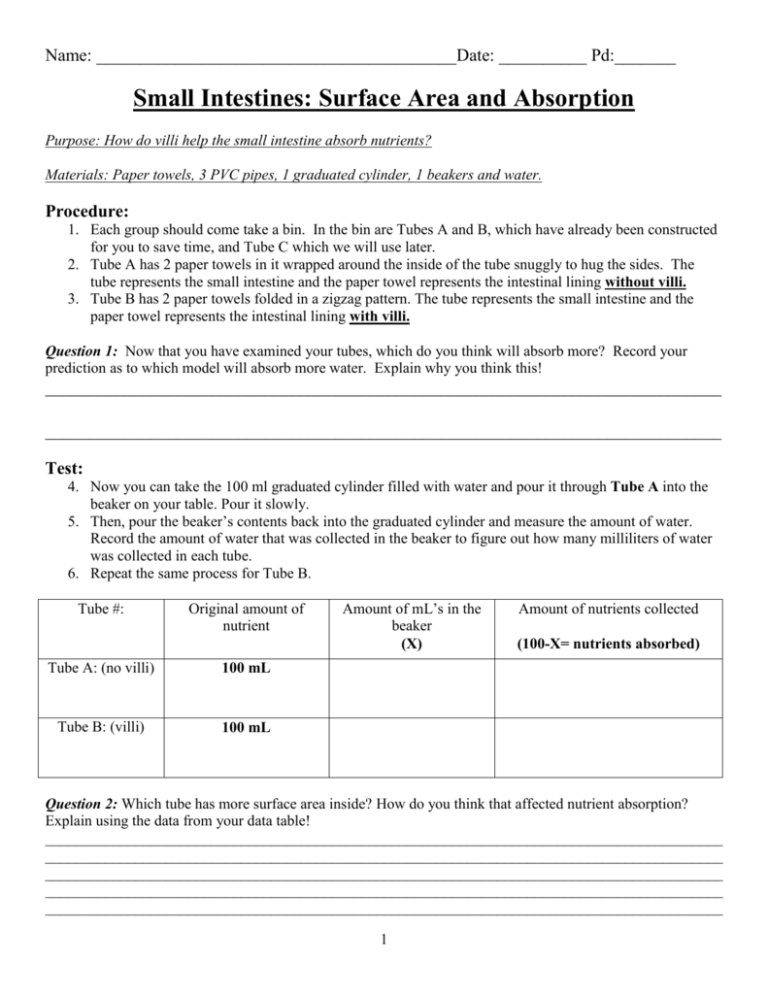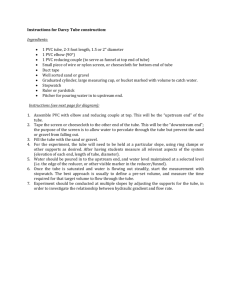Small Intestines: Surface Area and Absorption
advertisement

Name: _________________________________________Date: __________ Pd:_______ Small Intestines: Surface Area and Absorption Purpose: How do villi help the small intestine absorb nutrients? Materials: Paper towels, 3 PVC pipes, 1 graduated cylinder, 1 beakers and water. Procedure: 1. Each group should come take a bin. In the bin are Tubes A and B, which have already been constructed for you to save time, and Tube C which we will use later. 2. Tube A has 2 paper towels in it wrapped around the inside of the tube snuggly to hug the sides. The tube represents the small intestine and the paper towel represents the intestinal lining without villi. 3. Tube B has 2 paper towels folded in a zigzag pattern. The tube represents the small intestine and the paper towel represents the intestinal lining with villi. Question 1: Now that you have examined your tubes, which do you think will absorb more? Record your prediction as to which model will absorb more water. Explain why you think this! _____________________________________________________________________________ _____________________________________________________________________________ Test: 4. Now you can take the 100 ml graduated cylinder filled with water and pour it through Tube A into the beaker on your table. Pour it slowly. 5. Then, pour the beaker’s contents back into the graduated cylinder and measure the amount of water. Record the amount of water that was collected in the beaker to figure out how many milliliters of water was collected in each tube. 6. Repeat the same process for Tube B. Tube #: Original amount of nutrient Tube A: (no villi) 100 mL Tube B: (villi) 100 mL Amount of mL’s in the beaker (X) Amount of nutrients collected (100-X= nutrients absorbed) Question 2: Which tube has more surface area inside? How do you think that affected nutrient absorption? Explain using the data from your data table! __________________________________________________________________________________________ __________________________________________________________________________________________ __________________________________________________________________________________________ __________________________________________________________________________________________ __________________________________________________________________________________________ 1 7. Now that you have observed how absorption is affected by the presence and non-presence of villi, construct your own design for the small intestine. Engineer (using your 2 given paper towels) your own idea for how the villi should line the small intestine to create even more absorption? 8. What does your tube look like? Draw a picture of how you arranged the paper towel inside of it. 9. Pour 100 mls of water through your designed tube. Record the amount of nutrients absorbed in the table. Tube #: Tube 3: (engineered) Original amount of nutrient Amount of mL’s in the beaker (X) Amount of nutrients collected (100-X= nutrients absorbed) 100 mL Question 3: Was your engineered tube better or worse than the best tube above? Why do you think the small intestine is NOT engineered like your tube? Explain. _____________________________________________________________________________ _____________________________________________________________________________ _____________________________________________________________________________ Conclusion Question: What can you conclude from the data you collected in the lab? How do folds and finger-like projections affect the area of an absorbing surface? What do you think the inside of the small intestine looks like based on the best tube? _____________________________________________________________________________ _____________________________________________________________________________ _____________________________________________________________________________ _____________________________________________________________________________ 2








